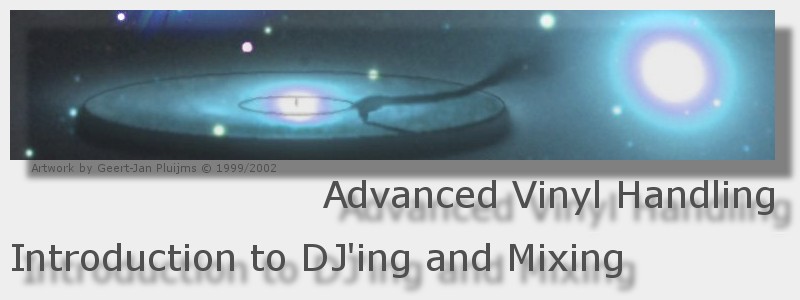Stage matching
Another thing you do not have to worry about when you begin mixing is the
overall track structure. Once you get to a stage where you can make transitions
of more than a minute or so, you can get yourself into trouble. This trouble
rises when you let 2 stages "collide". As was already mentioned in the
part on Track Structure, one should not mix through
a build up and climax.
In order to prevent this from happening, you have to start paying attention
to the stages of both records. Similar to beat matching,
bar matching and loop matching there is also stage matching
. As long as you make sure you have record 2 with the first beat of a
stage under the stylus and you jumpstart it at the start of a
stage of record 1 you are safe. Of course you still have stages that
do not necescarily consist of the same number of bars, but the chance of
"collision" is minimised. This is the situation you can get in a mix (not
taking into account that there usually is an additional break in a
track:
track 1 transition track 2 transition track 3
| | | |
...Break & Climax | Exit | | Body | Break & Climax ...
| Body | Break & Climax | Exit |
Back to the top.
"Doing a set"
This is your goal. In some way or another, for a crowd or for yourself,
recording the mix or just for direct listening pleasure only, you are
mixing: "You do a set". A set can be anything from, say, 5 records to several
hours worth of records. There are no real rules for a set/mix, just guidelines.
The best way to understand how it works is to listen to other DJs, either live
or recorded. You can think of doing a set as telling a story, build up from
little stories (that is: tracks). This analogy can be streched quite far.
There are 3 things that give a DJ his/her own style. The way they are making
the transitions, what kind of records they select and how they build up a set.
So, in order to stick to the analogy, I will tell you a possible way to tell
the story, but it is entirely up to you to decide what "story elements" you
want to bring in, and in which order you "tell" them.
When you tell a story, you don't start with the climax. So do not hit it
off with the biggest floorfiller unless you have other records to top that
throughout your set. Of course, when someone has been DJ-ing right before you
and you take over, you can pick up the story where the other DJ left, and
give it your own twist. After a gentle start you can tell more dramatic pieces
of the story, play more energetic music. Keep in mind that you have to give
the crowd a break once in a while, do not go full throttle all the time. So
you can play some slower more melodious tracks to let the crowd cool down.
You can adjust the master volume to follow the "suspense of the
storyline". As you near the end of your story, you make the plotline more and
more intense: building up the suspense and music volume. More energetic tracks
and gradually louder music untill you blow the top off. (See the similarities
between this and track structure ?)
The only way you can practice doing a set is to forget practicing on
separate skills and just start mixing. Recording your efforts can really
help because it enables you to listen to your own mixing without having to
concentrate on getting 2 records in phase Recording your own mixing
is also important because it can also give you some feeling for choice of
records within a mix and you get to know your own records better. Once you
are confident enough you can try to prepare a mix which is no longer for
"internal use only". Get everyone to listen to your tape and get feedback.
Back to the top.
| 
